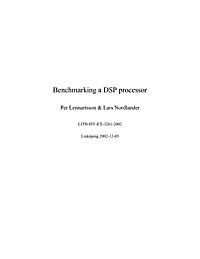
Benchmarking a DSP processor
This Master thesis describes the benchmarking of a DSP processor. Benchmarking means measuring the performance in some way. In this report, we have focused on the number of instruction cycles needed to execute certain algorithms. The algorithms we have used in the benchmark are all very common in signal processing today. The results we have reached in this thesis have been compared to benchmarks for other processors, performed by Berkeley Design Technology, Inc. The algorithms were programmed in assembly code and then executed on the instruction set simulator. After that, we proposed changes to the instruction set, with the aim to reduce the execution time for the algorithms. The results from the benchmark show that our processor is at the same level as the ones tested by BDTI. Probably would a more experienced programmer be able to reduce the cycle count even more, especially for some of the more complex benchmarks.
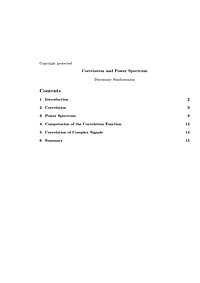
Correlation and Power Spectrum
In the signals and systems course and in the first course in digital signal processing, a signal is, most often, characterized by its amplitude spectrum in the frequency-domain and its amplitude profile in the time-domain. So much a student gets used to this type of characterization, that the student finds it difficult to appreciate, when encountered in the ensuing statistical signal processing course, the fact that a signal can also be characterized by its autocorrelation function in the time-domain and the corresponding power spectrum in the frequency-domain and that the amplitude characterization is not available. In this article, the characterization of a signal by its autocorrelation function in the time-domain and the corresponding power spectrum in the frequency-domain is described. Cross-correlation of two signals is also presented.
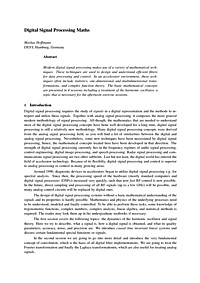
Digital Signal Processing Maths
Modern digital signal processing makes use of a variety of mathematical techniques. These techniques are used to design and understand efficient filters for data processing and control.
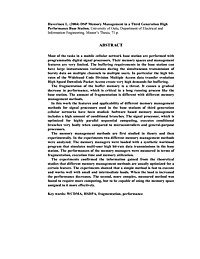
DSP Memory Management in a Third Generation High Performance Base Station
Most of the tasks in a mobile cellular network base station are performed with programmable digital signal processors. Their memory spaces and management features are very limited. The buffering requirements in the base station can have large instantaneous variations during the simultaneous transmission of burst' data on multiple channels to multiple users. In particular the high bit-rates of the Wideband Code Division Multiple Access data transfer evolution High Speed Downlink Packet Access create very high demands for buffering. The fragmentation of the buffer memory is a threat. It causes a gradual decrease in performance, which is critical in a long running process like the base station. The amount of fragmentation is different with different memory management methods. In this work the features and applicability of different memory management methods for signal processors used in the base stations of third generation cellular networks have been studied. Software based memory management includes a high amount of conditional branches. The signal processor, which is optimized for highly parallel sequential computing, executes conditional branches very badly when compared to microcontrollers and general-purpose processors. The memory management methods are first studied in theory and then experimentally. In the experiments two different memory management methods were analyzed. The memory managers were loaded with a synthetic workload program that simulates multi-user high bit-rate data transmissions in the base station. The performances of the memory managers were measured in terms of fragmentation, execution time and memory utilization. The experiments confirmed the information gained from the theoretical studies that different memory management methods are usually optimized for a certain feature. The experiments showed that a simple method is fast to execute and works well with small and intermediate loads. When the load is increased the performance decreases. The second, more complex, measured method was found to require more computing, but to be capable of using the memory space assigned to it more effectively.
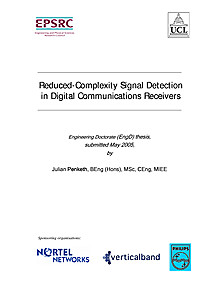
EngD thesis: Reduced-Complexity Signal Detection in Digital Communications Receivers
The Author began this Engineering Doctorate (EngD) in Autumn 1999, whilst already in full-time employment as a DSP software engineer at Nortel Networks, Harlow. This EngD comprises a set of three projects. The first project was focused on the development of dual-tone multi-frequency (DTMF) signal detection software. DTMF signals are currently used for operating menu-driven services such as voice-mail, telephone banking and share-dealing. The need for detection software in a packet networking environment exists because such signals become degraded when they travel through speech compression circuits. In addition, if they appear as echoes on a telephone line, they can affect the operation of echo cancellation systems. In this thesis a number of DSP algorithms are discussed where fast detection and minimum complexity are key characteristics. A key contribution here was the development of a novel detection algorithm based on the extraction of parameters that model the DTMF signal. The thesis reports a method combining parameter extraction with the technique of maximum likelihood to perform DTMF detection, resulting in very short time-frames when compared to standard approaches. Reducing the complexity of detection techniques is also important in today’s communication systems. To this end a key contribution here was the development of the ‘split Goertzel algorithm’, which permitted an overlapping of analysis windows without the need for reprocessing input data. Besides being applied to voice-band signals, such as in the case of DTMF, the Author also had the opportunity during the EngD to apply the skills and knowledge acquired in signal processing to higher-rate data-streams. This involved work concerning the equalisation of channel distortion commonly found in wireless communication systems. This covers two projects, with the first being conducted at Verticalband Ltd. (now no longer operational) in the area of digital television receivers. In this part of the thesis a real-time DSP implementation is discussed for enhancing a simulation system developed for wireless channels. A number of channel equalisation approaches are studied. The work concludes that for high-rate signals, non-linear algorithms have the best error rate performance. On the basis of the studies carried out, the thesis considers development and implementation issues of designs based on the decision feedback equaliser. The thesis reports on a software design which applies the method of least squares to carry out filter coefficient adaptation. The Verticalband studies reported lead on to further research within the context of channel equalisation, in the context of the detection of data in multiple-input multiple-output (MIMO) wireless local area network (WLAN) systems. This work was undertaken at Philips Research in Eindhoven, The Netherlands. The thesis discusses implementation scenarios of multi-element antenna arrays that aim to provide bit-rates orders of magnitude higher than today’s WLAN offerings, as those required by emerging standards such as 802.11n. The complexity of optimal detection techniques, such as maximum likelihood, scales exponentially with the number of transmit antennas. This translates to high processing costs and power consumption, rendering such techniques unsuitable for use in battery-powered devices. The initial main contribution here was the analysis of the complexity of algorithms whose performance had already been tested, such as the non-linear maximum likelihood approach and also less complex methods utilising linear filtering. This resulted in the development of new formulae to predict processing costs of algorithms based on the number of transmit and receive antennas. Other key contributions were defining a method to reduce the complexity of matrix inversion when using the Moore-Penrose pseudo-inverse, and the application of matrix decomposition to obviate the need for costly matrix inversion at all. Some on-going research into sub-optimal detection is also discussed, which describes methods to reduce the search-space for the maximum likelihood algorithm.

A Subspace Based Approach to the Design, Implementation and Validation of Algorithms for Active Vibration Isolation Control
Vibration isolation endeavors to reduce the transmission of vibration energy from one structure (the source) to another (the receiver), to prevent undesirable phenomena such as sound radiation. A well-known method for achieving this is passive vibration isolation (PVI). In the case of PVI, mounts are used - consisting of springs and dampers - to connect the vibrating source to the receiver. The stiffness of the mount determines the fundamental resonance frequency of the mounted system and vibrations with a frequency higher than the fundamental resonance frequency are attenuated. Unfortunately, however, other design requirements (such as static stability) often impose a minimum allowable stiffness, thus limiting the achievable vibration isolation by passive means. A more promising method for vibration isolation is hybrid vibration isolation control. This entails that, in addition to PVI, an active vibration isolation control (AVIC) system is used with sensors, actuators and a control system that compensates for vibrations in the lower frequency range. Here, the use of a special form of AVIC using statically determinate stiff mounts is proposed. The mounts establish a statically determinate system of high stiffness connections in the actuated directions and of low stiffness connections in the unactuated directions. The latter ensures PVI in the unactuated directions. This approach is called statically determinate AVIC (SD-AVIC). The aim of the control system is to produce antidisturbance forces that counteract the disturbance forces stemming from the source. Using this approach, the vibration energy transfer from the source to the receiver is blocked in the mount due to the anti-forces. This thesis deals with the design of controllers generating the anti-forces by applying techniques that are commonly used in the field of signal processing. The control approaches - that are model-based - are both adaptive and fixed gain and feedforward and feedback oriented. The control approaches are validated using two experimental vibration isolation setups: a single reference single actuator single error sensor (SR-SISO) setup and a single reference input multiple actuator input multiple error sensor output (SR-MIMO) setup. Finding a plant model can be a problem. This is solved by using a black-box modelling strategy. The plants are identified using subspace model identification. It is shown that accurate linear models can be found in a straightforward manner by using small batches of recorded (sampled) time-domain data only. Based on the identified models, controllers are designed, implemented and validated. Due to resonance in mechanical structures, adaptive SD-AVIC systems are often hampered by slow convergence of the controller coefficients. In general, it is desirable that the SD-AVIC system yields fast optimum performance after it is switched on. To achieve this result and speed up the convergence of the adaptive controller coefficients, the so-called inverse outer factor model is included in the adaptive control scheme. The inner/outer factorization, that has to be performed to obtain the inverse outer factor model, is completely determined in state space to enable a numerically robust computation. The inverse outer factor model is also incorporated in the control scheme as a state space model. It is found that fast adaptation of the controller coefficients is possible. Controllers are designed, implemented and validated to suppress both narrowband and broadband disturbances. Scalar regularization is used to prevent actuator saturation and an unstable closed loop. In order to reduce the computational load of the controllers, several steps are taken including controller order reduction and implementation of lower order models. It is found that in all experiments the simulation and real-time results correspond closely for both the fixed gain and adaptive control situation. On the SR-SISO setup, reductions up to 5.0 dB are established in real-time for suppressing a broadband disturbance output (0-2 kHz) using feedback-control. On the SR-MIMO vibration isolation setup, using feedforward-control reductions of broadband disturbances (0-1 kHz) of 9.4 dB are established in real-time. Using feedback-control, reductions are established up to 3.5 dB in real-time (0-1 kHz). In case of the SR-MIMO setup, the values for the reduction are obtained by averaging the reductions obtained in all sensor outputs. The results pave the way for the next generation of algorithms for SD-AVIC.
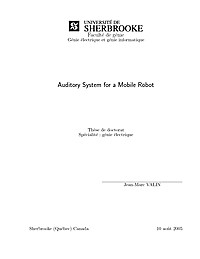
Auditory System for a Mobile Robot
The auditory system of living creatures provides useful information about the world, such as the location and interpretation of sound sources. For humans, it means to be able to focus one's attention on events, such as a phone ringing, a vehicle honking, a person taking, etc. For those who do not suffer from hearing impairments, it is hard to imagine a day without being able to hear, especially in a very dynamic and unpredictable world. Mobile robots would also benefit greatly from having auditory capabilities. In this thesis, we propose an artificial auditory system that gives a robot the ability to locate and track sounds, as well as to separate simultaneous sound sources and recognising simultaneous speech. We demonstrate that it is possible to implement these capabilities using an array of microphones, without trying to imitate the human auditory system. The sound source localisation and tracking algorithm uses a steered beamformer to locate sources, which are then tracked using a multi-source particle filter. Separation of simultaneous sound sources is achieved using a variant of the Geometric Source Separation (GSS) algorithm, combined with a multisource post-filter that further reduces noise, interference and reverberation. Speech recognition is performed on separated sources, either directly or by using Missing Feature Theory (MFT) to estimate the reliability of the speech features. The results obtained show that it is possible to track up to four simultaneous sound sources, even in noisy and reverberant environments. Real-time control of the robot following a sound source is also demonstrated. The sound source separation approach we propose is able to achieve a 13.7 dB improvement in signal-to-noise ratio compared to a single microphone when three speakers are present. In these conditions, the system demonstrates more than 80% accuracy on digit recognition, higher than most human listeners could obtain in our small case study when recognising only one of these sources. All these new capabilities will allow humans to interact more naturally with a mobile robot in real life settings.
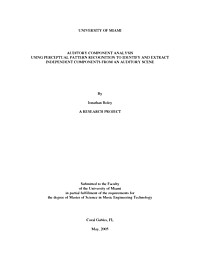
Auditory Component Analysis Using Perceptual Pattern Recognition to Identify and Extract Independent Components From an Auditory Scene
The cocktail party effect, our ability to separate a sound source from a multitude of other sources, has been researched in detail over the past few decades, and many investigators have tried to model this on computers. Two of the major research areas currently being evaluated for the so-called sound source separation problem are Auditory Scene Analysis (Bregman 1990) and a class of statistical analysis techniques known as Independent Component Analysis (Hyvärinen 2001). This paper presents a methodology for combining these two techniques. It suggests a framework that first separates sounds by analyzing the incoming audio for patterns and synthesizing or filtering them accordingly, measures features of the resulting tracks, and finally separates sounds statistically by matching feature sets and making the output streams statistically independent. Artificial and acoustical mixes of sounds are used to evaluate the signal-to-noise ratio where the signal is the desired source and the noise is comprised of all other sources. The proposed system is found to successfully separate audio streams. The amount of separation is inversely proportional to the amount of reverberation present.
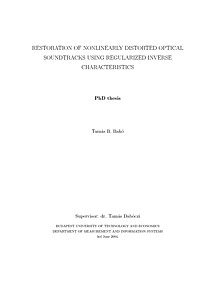
Restoration of Nonlinearly Distorted Optical Soundtracks Using Regularized Inverse Characteristics
This dissertation is concerned with the possibilities of restoration of degraded film-sound. The sound-quality of old films are often not acceptable, which means that the sound is so noisy and distorted that the listener have to take strong efforts to understand the conversations in the film. In this case the film cannot give artistic enjoyment to the listener. This is the reason that several old films cannot be presented in movies or television. The quality of these films can be improved by digital restoration techniques. Since we do not have access to the original signal, only the distorted one, therefore we cannot adjust recording parameters or recording techniques. The only possibility is to post-compensate the signal to produce a better estimate about the undistorted, noiseless signal. In this dissertation new methods are proposed for fast and efficient restoration of nonlinear distortions in the optically recorded film soundtracks. First the nonlinear models and nonlinear restoration techniques are surveyed and the ill-posedness of nonlinear post-compensation (the extreme sensitivity to noise) is explained. The effects and sources of linear and nonlinear distortions at optical soundtracks are also described. A new method is proposed to overcome the ill-posedness of the restoration problem and to get an optimal result. The effectiveness of the algorithm is proven by simulations and restoration of real film-sound signals.
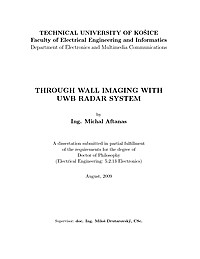
Through-Wall Imaging with UWB Radar System
Motivation: A man was interested in knowing of unknown from the very beginning of the human history. Our human eyes help us to investigate our environment by reflection of light. However, wavelengths of visible light allows transparent view through only a very small kinds of materials. On the other hand, Ultra WideBand (UWB) electromagnetic waves with frequencies of few Gigahertz are able to penetrate through almost all types of materials around us. With some sophisticated methods and a piece of luck we are able to investigate what is behind opaque walls. Rescue and security of the people is one of the most promising fields for such applications. Rescue: Imagine how useful can be information about interior of the barricaded building with terrorists and hostages inside for a policemen. The tactics of police raid can be build up on realtime information about ground plan of the room and positions of big objects inside. How useful for the firemen can be information about current interior state of the room before they get inside? Such hazardous environment, full of smoke with zero visibility, is very dangerous and each additional information can make the difference between life and death. Security: Investigating objects through plastic, rubber, dress or other nonmetallic materials could be highly useful as an additional tool to the existing x-ray scanners. Especially it could be used for scanning baggage at the airport, truckloads on borders, dangerous boxes, etc.
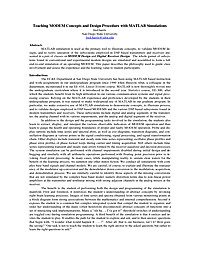
Teaching MODEM Concepts and Design Procedure with MATLAB Simulations
MATLAB simulation is used as the primary tool to illustrate concepts, to validate MODEM designs, and to vent' operation of the subsystems employed in DSP based transmitters and receivers presented in a pair of classes on MODEM Design and Digital Receiver Design. The whole gamut of subsystems found in conventional and experimental modem designs are simulated and assembled to form a full end-to-end simulation of an operating MODEM. This paper describes the philosophy used to guide class involvement and assess the experience and the learning value to student participants.
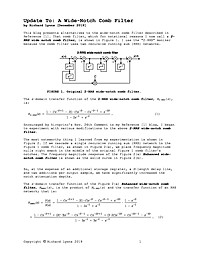
Update To: A Wide-Notch Comb Filter
This article presents alternatives to the wide-notch comb filter described in Reference [1].
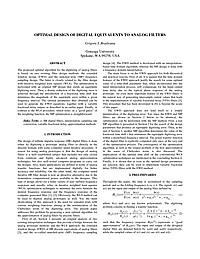
OPTIMAL DESIGN OF DIGITAL EQUIVALENTS TO ANALOG FILTERS
The proposed optimal algorithm for the digitizing of analog filters is based on two existing filter design methods: the extended window design (EWD) and the matched–pole (MP) frequency sampling design. The latter is closely related to the filter design with iterative weighted least squares (WLS). The optimization is performed with an original MP design that yields an equiripple digitizing error. Then, a drastic reduction of the digitizing error is achieved through the introduction of a fractional time shift that minimizes the magnitude of the equiripple error within a given frequency interval. The optimal parameters thus obtained can be used to generate the EWD equations, together with a variable fractional delay output, as described in an earlier paper. Finally, in contrast to the WLS procedure, which relies on a “good guess” of the weighting function, the MP optimization is straightforward.
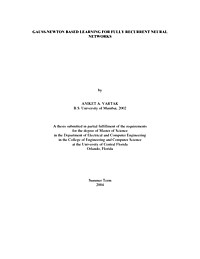
Gauss-Newton Based Learning for Fully Recurrent Neural Networks
The thesis discusses a novel off-line and on-line learning approach for Fully Recurrent Neural Networks (FRNNs). The most popular algorithm for training FRNNs, the Real Time Recurrent Learning (RTRL) algorithm, employs the gradient descent technique for finding the optimum weight vectors in the recurrent neural network. Within the framework of the research presented, a new off-line and on-line variation of RTRL is presented, that is based on the Gauss-Newton method. The method itself is an approximate Newton’s method tailored to the specific optimization problem, (non-linear least squares), which aims to speed up the process of FRNN training. The new approach stands as a robust and effective compromise between the original gradient-based RTRL (low computational complexity, slow convergence) and Newton-based variants of RTRL (high computational complexity, fast convergence). By gathering information over time in order to form Gauss-Newton search vectors, the new learning algorithm, GN-RTRL, is capable of converging faster to a better quality solution than the original algorithm. Experimental results reflect these qualities of GN-RTRL, as well as the fact that GN-RTRL may have in practice lower computational cost in comparison, again, to the original RTRL.
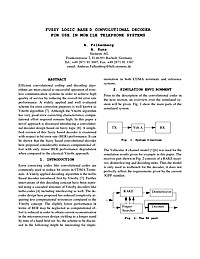
FUZZY LOGIC BASED CONVOLUTIONAL DECODER FOR USE IN MOBILE TELEPHONE SYSTEMS
Efficient convolutional coding and decoding algorithms are most crucial to successful operation of wireless communication systems in order to achieve high quality of service by reducing the overall bit error rate performance. A widely applied and well evaluated scheme for error correction purposes is well known as Viterbi algorithm [7]. Although the Viterbi algorithm has very good error correcting characteristics, computational effort required remains high. In this paper a novel approach is discussed introducing a convolutional decoder design based on fuzzy logic. A simplified version of this fuzzy based decoder is examined with respect to bit error rate (BER) performance. It can be shown that the fuzzy based convolutional decoder here proposed considerably reduces computational effort with only minor BER performance degradation when compared to the classical Viterbi approach.
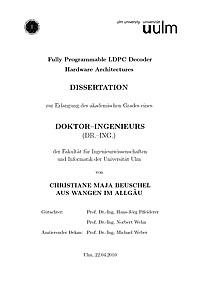
Fully Programmable LDPC Decoder Hardware Architectures
In recent years, the amount of digital data which is stored and transmitted for private and public usage has increased considerably. To allow a save transmission and storage of data despite of error-prone transmission media, error correcting codes are used. A large variety of codes has been developed, and in the past decade low-density parity-check (LDPC) codes which have an excellent error correction performance became more and more popular. Today, low-density parity-check codes have been adopted for several standards, and efficient decoder hardware architectures are known for the chosen structured codes. However, the existing decoder designs lack flexibility as only few structured codes can be decoded with one decoder chip. In consequence, different codes require a redesign of the decoder, and few solutions exist for decoding of codes which are not quasi-cyclic or which are unstructured. In this thesis, three different approaches are presented for the implementation of fully programmable LDPC decoders which can decode arbitrary LDPC codes. As a design study, the first programmable decoder which uses a heuristic mapping algorithm is realized on an field-programmable gate array (FPGA), and error correction curves are measured to verify the correct functionality. The main contribution of this thesis lies in the development of the second and the third architecture and an appropriate mapping algorithm. The proposed fully programmable decoder architectures use one-phase message passing and layered decoding and can decode arbitrary LDPC codes using an optimum mapping and scheduling algorithm. The presented programmable architectures are in fact generalized decoder architectures from which the known decoders architectures for structured LDPC codes can be derived.
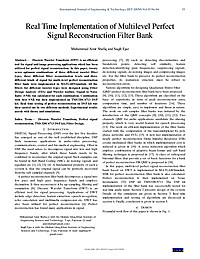
Real Time Implementation of Multi-Level Perfect Signal Reconstruction Filter Bank
Discrete Wavelet Transform (DWT) is an efficient tool for signal and image processing applications which has been utilized for perfect signal reconstruction. In this paper, twenty seven optimum combinations of three different wavelet filter types, three different filter reconstruction levels and three different kinds of signal for multi-level perfect reconstruction filter bank were implemented in MATLAB/Simulink. All the filters for different wavelet types were designed using Filter Design Analysis (FDA) and Wavelet toolbox. Signal to Noise Ratio (SNR) was calculated for each combination. Combination with best SNR was then implemented on TMS320C6713 DSP kit. Real time testing of perfect reconstruction on DSP kit was then carried out by two different methods. Experimental results accede with theory and simulations.
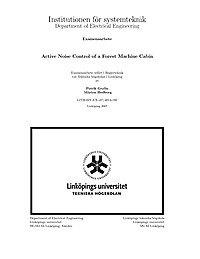
Active Noise Control of a Forest Machine Cabin
Today, a high noise level is considered a problem in many working environments. The main reason is that it contributes to stress and fatigue. Traditional methods using passive noise control is only practicable for high frequencies. As a complement to passive noise control, active noise control (ANC) can be used to reduce low frequency noise. The main idea of ANC is to use destructive interference of waves to cancel disturbing noises. The purpose of this thesis is to design and implement an ANC system in the driver's cabin of a Valmet 890 forest machine. The engine boom is one of the most disturbing noises and therefore the main subjective for the ANC system to suppress. The ANC system is implemented on a Texas Instrument DSP development starter kit. Different FxLMS algorithms are evaluated with feedback and feedforward configurations. The results indicate that an ANC system significantly reduces the sound pressure level (SPL) in the cabin. Best performance of the evaluated systems is achieved for the feedforward FxLMS system. For a commonly used engine speed of 1500 rpm, the SPL is reduced with 17 dB. The results show fast enough convergence and global suppression of low frequency noise.
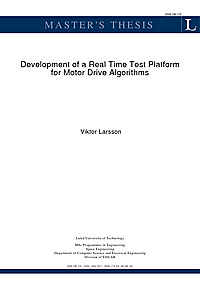
Development of a real time test platform for motor drive algorithms
In this thesis a real time test platform for a permanent magnet synchronous motor is developed. The implemented algorithm is Field Oriented Control (FOC) and it is implemented on a Texas Instruments TMS320F2808 Digital Signal Processor (DSP). The platform is developed in a rapid prototyping approach using Matlab/Simulink and the Real Time Workshop (RTW) packages.With this software the control algorithm and its interface to different DSP modules, such as A/D converter and PWM module, is constructed as a Simulink block scheme. The blocks used come from ordinary Simulink libraries and libraries provided by the RTW packages. From the Simulink block scheme Matlab can auto generate embedded C code adapted for different embedded targets, in this case the 2808 DSP.The developed real time test platform is also a Simulink model, though different from the algorithm model. When the start simulation command is given in the platform model a Graphical User Interface is loaded which lets the user specify motor parameters and certain algorithm parameters. Once the parameters are chosen RTW generates code from the algorithm model, loads it into the DSP and runs the generated program. From the platform model it is possible to set the reference speed of the motor in real time and monitor/log motor parameters such as actual speed and stator currents.

Auditory Component Analysis Using Perceptual Pattern Recognition to Identify and Extract Independent Components From an Auditory Scene
The cocktail party effect, our ability to separate a sound source from a multitude of other sources, has been researched in detail over the past few decades, and many investigators have tried to model this on computers. Two of the major research areas currently being evaluated for the so-called sound source separation problem are Auditory Scene Analysis (Bregman 1990) and a class of statistical analysis techniques known as Independent Component Analysis (Hyvärinen 2001). This paper presents a methodology for combining these two techniques. It suggests a framework that first separates sounds by analyzing the incoming audio for patterns and synthesizing or filtering them accordingly, measures features of the resulting tracks, and finally separates sounds statistically by matching feature sets and making the output streams statistically independent. Artificial and acoustical mixes of sounds are used to evaluate the signal-to-noise ratio where the signal is the desired source and the noise is comprised of all other sources. The proposed system is found to successfully separate audio streams. The amount of separation is inversely proportional to the amount of reverberation present.


















